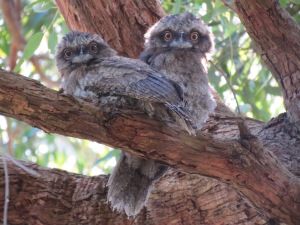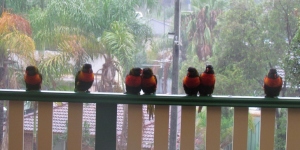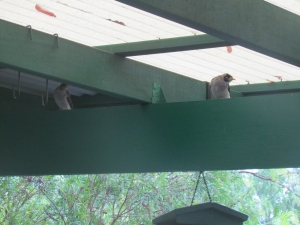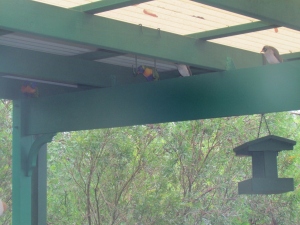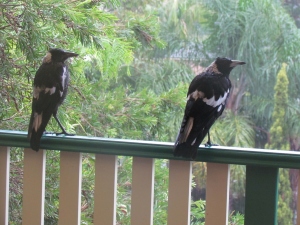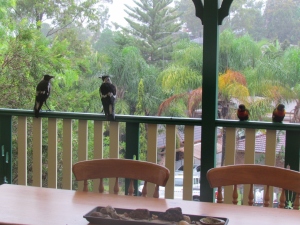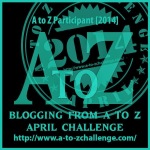In Stitches
March 13, 2016 at 12:58 pm | Posted in Australia, Nature, Poetry, Writing | 27 CommentsTags: creativity, gratitude, Lake Macquarie NSW, Morisset Show, nature
I have been occupied with other things than this blog lately. However, I would like to share a poem with you that I wrote a few years ago. It is about the beautiful Lake Macquarie where I live, and how I saw it one day as I walked along the shore.
The poem was recently commended in the Morisset Show Poetry Competition.
Wangi Bay stretches before me,
a coarse wind-ruffled
grey-green fabric;
patches of dirty brown
rain-stirred run-off
tacked onto it here and there
like jungle-camouflage.
Silver sequins
tossed onto the watery quilt
tumble and sparkle among
the grey jetty stripes and squares
and the multi-coloured
ship-shaped pieces
that have been tacked on
with contrasting whitecap stitches.
Here and there,
in out-of-the-way places
an occasional dot
of white embroidery –
a bobbing seagull or pelican.
A narrow, irregular strip
of breaking waves
marks the inner border
separating the nautical pattern
from its dark green edging
of eucalypt and casuarina
and spiky Lomandra longifolia
Today, the lake is a patch-work quilt
that I would like to take home with me.
© Linda Visman
11th October, 2010
A to Z Challenge _ Z is for Zephyr
April 30, 2015 at 12:05 am | Posted in A-Z Blogging Challenge 2015, Poetry | 7 CommentsTags: emotions, grief, nature, wind
.
I wrote this poem in fifteen minutes as I sat by the open door with a gentle night breeze playing on my skin.
.
Zephyr Breeze
.
Zephyr breeze
Wafts through the window,
Bringing soft coolness
To fevered brow.
.
Zephyr breeze
Stirs autumn trees,
Causing golden shower
Of whispering leaves.
.
Zephyr breeze
Drifts in from the ocean,
Bringing the promise
Of evening rain.
.
Zephyr breeze
I wished you a tempest,
Reflecting the tumult
Of my grieving soul.
.
Zephyr breeze
Instead you stayed gentle,
Easing the turmoil
And bringing me peace.
.
(c) Linda Visman
Evening Light
May 8, 2014 at 5:35 pm | Posted in Gardens, Nature | 3 CommentsTags: autumn light, nature
I love the light outside on clear autumn evenings, when everything has been washed clean by the rain.
The colours are enhanced by a golden glow,
Their shapes made clear and well defined.
Every flower, every leaf, every trunk and branch is perfectly itself.
Even the garbage bins and staircase bannister glow.
The greens are greener, the yellows yellower,
Their gradations of intensity more well-defined.
A red-brown shines out from the dark soil,
Which is usually a dull grey-brown.
The blue of the sky fits perfectly with the trees.
I don’t try to catch the clarity and perfection through the lens of a camera;
I have tried before and failed.
Nothing can reproduce those fleeting tones- except perhaps a great painter.
I just wrote this as the light fades outside my study window. I wish my words could capture it much better.
(c) Linda Visman 08.05.14
Tawny Frogmouths in my Back Yard
November 28, 2013 at 12:21 pm | Posted in Australia, Gardens, Nature | 5 CommentsTags: Australian birds, baby animals, birds, birds in backyards, nature, owls, Podargus strigoides, tawny frogmouth
The tawny frogmouths are back!
Mum and Dad and two little ones turned up in one of the trees in our back yard the other day. My husband has been taking photos of them.
There is something special about these birds. The tawny frogmouth (Podargus strigoides) is actually not an owl, though it is usually mistaken for one.
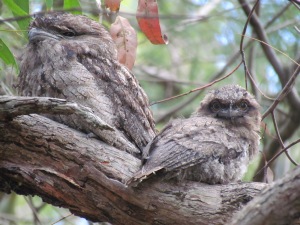
The forward facing eyes are very owl-like, and this is one of the reasons owls are a favourite with many people. We do tend to anthropomorphise animals at times.
The babies too are very appealing with their large eyes, fluffy feathers and inquisitive nature.
Tawnies have a defence mechanism against any predators that might relish one – they elongate their body and imitate a broken-off branch. That, and their natural camouflage, makes them almost invisible in their favourite trees.
I love having the tawnies around, especially in breeding season. They add to the wildlife, especially birds, that flourish in our back yard.
(c) Linda Visman
The Australian Bush Calls
July 14, 2013 at 3:18 pm | Posted in Australia, Nature, Ways of Living | 9 CommentsTags: Australia.bush, call of nature, forest, indigenous, nature
Every time we drive past an area of bushland – especially where there are no farms or cleared land, it’s as if a strong piece of string is tied to something within me. This string pulls at me with a tug that I feel in the heart and gut. I am called to wander in that bushland, unencumbered by modern possessions, to follow the animal tracks and be guided only by the ancient lights in the sky.
I feel a strong urge to feel the earth, the fallen leaves and twigs, and the rough grass against my feet. To be sheltered among the eucalypt, grevillea and banksia of the dry forest, the paperbark melaleuca and the casuarina of the wetlands. In natural forest clearings, I want to feel the warm sun and the cool breeze on my skin.
I long to experience it all; to be at one with the plants and animals of the bush. I want to shed the trappings of civilisation, with their stresses and expectations, and go back to the primitive within me that hears the call. I have felt this call more mildly ever since I was a child but now, in my later years, it is strong and insistent.
It’s not that I want to be there forever, but I want to be immersed in nature for long enough to become connected – or re-connected – to the reality and the spirituality of nature; and I would like to do it more than once.
I know that I couldn’t live in the wild for long, as I have not learned the needed skills. But I believe I could at least come to a partial understanding of nature’s ways, and to a greater appreciation of its relevance – indeed, to its essential and continuing importance – for humanity. For if we lose that connection that it is fast becoming a tenuous one, we will also lose ourselves and all that has given us life.
© Linda Visman
Taking Shelter
January 28, 2013 at 4:01 pm | Posted in Australia, Nature | 8 CommentsTags: climate, cyclones, magpie, nature, noisy miner, NSW floods, Queensland floods, Rainbow lorikeet, refuge, shelter, storm
It has been raining here for two days as the remnants of Cyclone Oswald reach to the southern areas of eastern Australia. It will get worse, with stronger winds added to the rain. We will be fine where we are, but others won’t be as lucky.
There are thousands of people in Queensland and in northern NSW who are having it very tough at present. Many have been flooded from their homes and businesses. There have been deaths usually as people try to cross through swollen creeks and flooded causeways. (Some folk never learn).
States of emergency have been declared in some areas, and all emergency services are flat out helping those who are in trouble. Then they get some idiot like the one here.
As the rain falls and the wind blows, we look out onto our front verandah and see that other creatures are affected by the weather too. Our verandah always becomes a refuge for birds trying to get out of the rain, especially rainbow lorikeets.
We also have the ubiquitous noisy miners which, for once don’t gang up against the other birds. They all look rather forlorn at times like this
Today, I also managed to photograph a couple of the magpies that decided to take shelter there too. They don’t often come this high (the verandah is at second-storey level on our sloping block). They spend most of their time hunting for bugs and other creatures in their territory, which includes the lawns of other houses within an area of about a hundred metres radius of us.
I hope that the people affected by the floods are able to find shelter – just as these birds have done.
© Linda Visman
28th January 2013
Pink
February 9, 2011 at 9:24 am | Posted in Philosophy | 4 CommentsTags: beauty, colour preferences, flowers, gender differentiation, nature, pink
Pink is simply the name for a colour composed of a mixture of red and white. There are so many shades of pink that one is exhausted repeating them all. Lots of them are named after flowers, which carry the greatest variety of shades in nature. Some of the latest colours are given more striking names – shocking pink is an example.
I have always disliked – nay, I have always hated pink. To me it has been a soppy colour, only meant for those primping females who thought more of their appearance than any character strengths. It was the colour for weak and sissy girls, and even though I was a girl, I was always determined that pink should never represent me. I wanted to be a boy, so pink was NEVER my colour.
Even now, in the days of gender equality, pink is for girls. When I go to a department store and pass by the girls’ clothing section, all I see is pink. They are, at least, bright pinks nowadays, not the pale, insipid pastels of my childhood and early adult years. The colour now has a bit of attitude and character. I still hate seeing all those pretty and not so pretty little girls dressed in it though – vying for the perfect pinkness perhaps.
The colour has even become the name of a popular singer. “Pink” took the girl world by storm a few years ago. I have no idea what she sings or how good she is but, with that name, she has probably become one of the mega-rich of the entertainment world. Unless she has spent it all unwisely – not at all unusual these days.
I remember the fad for pink in decoration – was it the 1950s or the 1960s? Anyway, everywhere you went, you came across pink living rooms, pink waiting rooms, even pink houses. Trouble was, the quality of the paints in those days was not the best, and those ‘lovely’ pinks soon turned into drab, flaking or powdery calamities.
No matter what I think of pink as a gender defining colour or as decoration for buildings, it is always a beautiful colour in nature. Who can deny the splendour of a pink crepe myrtle in bloom, or the softness and fragility of a pink rose? Tell me something more striking than a field of pink tulips or cherry blossom in full show. But I still didn’t like pink anywhere else.
Then, two years ago, I became personally involved with pink. My breast cancer brought me into contact with a movement that is represented by a pink ribbon. I even wore pink when I attended fund-raising events, and I now own three pink T-shirts. And I wear them at other times occasionally. It seems that my hatred of pink has undergone quite an about-face.
Cicada Summer
January 3, 2011 at 6:37 am | Posted in Nature | 2 CommentsTags: back yard, Black Prince, cicada, insects, kookaburra, Life cycle, nature
The young one was the same size as its parent, and I marvelled at the speed that they grow. It hopped up and down a couple of times, getting up the courage to make the leap. The parent called again and the youngster took off. It flew a little unsteadily and landed right next to the adult, wobbling a little It then grabbed the live cicada, lifted its head and swallowed it whole. This was a really great incentive for the youngster to practice its flying. The kookas have done well this year; a veritable feast of cicadas has ensured many well-fed young.
The cicadas have all been Black Princes; no Greengrocers or Double Drummers among them. They have been plentiful and the noise they make is often so deafening that people have to almost shout to hear what someone is saying, even when standing beside them. It is the males that create this noise by vibrating their tymbals, drum-like organs found on their abdomens, to attract a female. That penetrating noise lets you know it really is summer, in light to heavily wooded parts of Australia – and we have plenty of trees where we live.
One day before Christmas, as I went out our back door, I saw something drop from the top of one of our large spotted gums. It was a cicada. When I looked more closely, I could see that the pale smooth new surface of the tree trunk was spotted all over with the black insects, gripping the bark with their claws. As I walked past, to get to the clothesline, some took off and flew all around and above me. I noticed quite a number on the ground, dead and dying. The ants had been at most of them, and only the hard shell of their heads, complete with popping eyes, and their brittle, clear, black-laced wings remained. They had mated and died; the final part of their life cycle completed.
It was only a few short weeks since they had emerged from the ground as nymphs in their original brown protective shells. The nymphs had lived for anything up to seven years underground, feeding on sap from tree roots. Then, something tells them it is time to emerge to mate. They clamber up a tree or post and shed their shell casings. These look like empty insect-shaped armoured tanks, clinging to tree trunks. They are no longer of use, and the cicadas that emerge take to the air for that last short, burst of life.
(c) Linda Visman
03 January 2011
Blog at WordPress.com.
Entries and comments feeds.
![A2Z-BADGE [2015] - Life is Good](https://wangiwriter.files.wordpress.com/2015/04/a2z-badge-2015-life-is-good.jpg?w=300&h=300)


